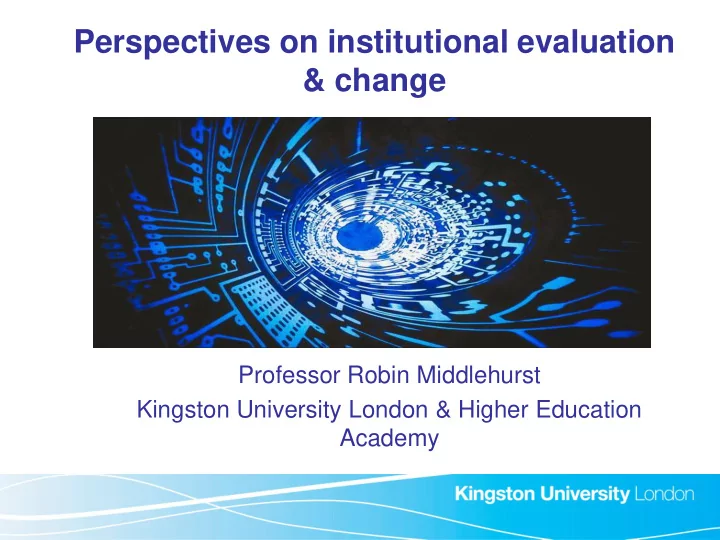

Perspectives on institutional evaluation & change Professor Robin Middlehurst Kingston University London & Higher Education Academy
Outline • Key questions • A changing environment for higher education • Drivers, impact • Evaluation & measurement in higher education • Sources, focus, methods • The Change agenda • QA & institutional change • Future prospects?
Key Questions • What are the drivers of change in HE? • General & country-specific • What are we evaluating & measuring? • Are we measuring what matters? • What changes are being sought in HE? • Are evaluation systems aligned & appropriate as drivers of institutional change? • Models of change • What kinds of approaches do we need in future?
Drivers of change in HE • Economic competitiveness in a knowledge economy (quality & innovation) • Social & cultural development: social cohesion, access & mobility, employability, social justice • Globalisation & internationalisation • European (& other regional) development • Technological change (convergence & speed) • Financial stability & sustainability • Big global (& local) challenges
International higher education challenges • USA – cost of HE, student progression & success • Australia – cost of HE, economic change, internationalisation, technology developments • Brazil, Indonesia – research quality and competitiveness, economic & social development • Japan – demographic change & internationalisation • KSA – research development, HE expansion • Malaysia – developing nation status by 2020 • UK – cost & efficiency of HE, research & innovation, international competitiveness • South Africa – social transformation, quality enhancement
Policy developments • Funding changes (Australia, UK) • HE expansion – public & private sectors (China, Middle East, Asia) • Enhancing research (Germany, Brazil, KSA) • Enhancing teaching & learning (US, UK, Hong Kong, Europe) • Enterprise & Entrepreneurship (US, UK, Australia, Europe) • Governance & management (Scotland, Wales) • ?? Community engagement & development
What & how are we evaluating?
International Rankings: position, reputation
Rankings - International
What are we measuring?
What are we measuring?
What are we measuring?
What are we measuring?
Subject accreditations
Evaluating management
Evaluating management
Evaluating research
Evaluating research
Evaluating teaching & learning
Evaluating teaching & learning • Institution-wide QA policies • Developing a quality culture at HEI level • Programme monitoring • Measuring design, content & delivery of programmes • Teaching & learning support • Continuing education for faculty, pedagogy enhancement, support for student learning (OECD/IMHE 2008)
Principles of good practice in undergraduate education • Student-faculty contact • Co-operation among students & influential interactions with other students • Active learning & time on task • Prompt feedback to students • High expectations • Quality of teaching received • Respecting diverse talents and ways of learning (Gibbs, 2010)
Are we measuring what matters?
Change agendas: EU Modernisation of HE
EU change agenda for teaching & learning
Change models - 1
Change models - 2
People & the change cycle
Innovation - 1
Innovation - 2
Looking to the future…
Looking to the future…
In conclusion, what matters is…. Innovation & creativity… The higher education ecosystem which involves collaboration & partnerships… Transformational change (doing things differently & doing different things) not just doing more of the same or doing the same things better…
…& don’t forget the problems with measurement! The first step is to measure whatever can be easily measured. This is OK as far as it goes. The second step is to disregard that which can't be easily measured or to give it an arbitrary quantitative value. This is artificial and misleading. The third step is to presume that what can't be measured easily really isn't important. This is blindness. The fourth step is to say that what can't be easily measured really doesn't exist. This is suicide. Daniel Yankelovich "Corporate Priorities: A continuing study of the new demands on business." (1972)
Recommend
More recommend